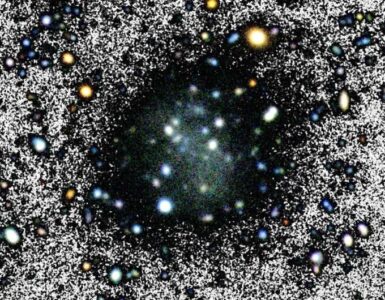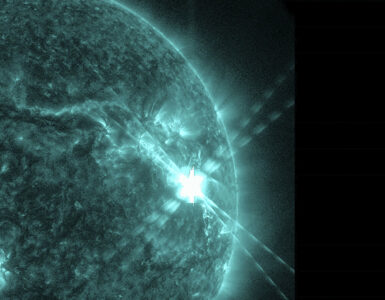by Rhodilee Jean Dolor
In its infancy, the universe had equal amounts of matter and antimatter, but 14 billion years after the Big Bang, the cosmos is now predominantly made up of matter. How this exactly happened remains a mystery, but scientists could be closer to the answer with recent breakthroughs in the field of particle physics.
Matter And Antimatter
According to the Standard Model, which describes how the fundamental particles in the universe interact, each elementary particle has an antiparticle with the same mass but an opposite charge. These antiparticles are collectively known as antimatter.
Because antimatter and matter have the same mass but carry opposite charges, they annihilate each other when they collide. The Standard Model posits that there were equal amounts of matter and antimatter when the universe was created, but matter eventually got the upper hand.
“We have this apparent complete symmetry of accounting between matter and antimatter,” explained Thomas O’Donnell, professor of physics at Virginia Tech University. “Every time you make a piece of matter, you also make a balancing piece of antimatter, and every time you destroy a piece of matter, you must destroy a piece of antimatter. If this is true, you can never have more of one type than the other.”
How matter dominated the universe is still unclear, but two new studies may hold the potential answer to this long-standing mystery.
Nuclei In Thorium-228 Atoms
Dr. David O’Donnell, lecturer in the Nuclear Physics Group at the University of the West of Scotland, and colleagues discussed the properties of an element that may help explain why matter now exists more abundantly than antimatter.
Scientists think that the so-called electric dipole moment (EDM) allows matter and antimatter to decay at different rates, which can help explain the asymmetry of matter and antimatter beyond the Standard Model.
Physicists also believe that they can best observe EDM in pear-shaped nuclei because the protons and neutrons are not evenly distributed in the nuclear volume.
In their study published in the journal Nature Physics on May 18, O’Donnell and colleagues revealed that thorium-228 atoms so far have the most pronounced pear-shaped nucleus that has been discovered to date.
“These nuclei present a promising avenue in the search for a permanent atomic electric dipole moment—the existence of which has implications for physics beyond the Standard Model of particle physics,” the researchers wrote in their study. “This study indicates that the nuclei 229Th and 229Pa (Z = 91) may be good candidates for the search for a permanent atomic electric dipole moment.”
Neutrino Oscillations
Another study, published in the journal Nature on April 15 also holds promise in solving the matter-antimatter asymmetry.
The research involves neutrinos, one of the fundamental particles of the universe. Neutrinos come in three flavours, namely electron, muon and tau, that may spontaneously change, or oscillate, from one to another as they travel, a phenomenon known as neutrino oscillation.
Using data from the Tokai to Kamioka (T2K) project in Japan, which conducts experiments to investigate how neutrinos change from one flavor to another as they travel, researchers found evidence that backs up the role of neutrinos in the current abundance of matter.
Each of the three neutrino flavors have a corresponding antineutrino. If the flavors change or oscillate differently for neutrinos and antineutrinos, it could explain the dominance of matter in the universe.
Researchers have been looking for a source of the so-called Charge-Parity (CP) symmetry in neutrino oscillations which may show up as a difference in the measured oscillation probability for neutrinos and antineutrinos.
T2K experiments use beams of muon neutrinos or muon antineutrinos that travel from the Japan Proton Accelerator Research Complex (J-PARC) in Tokai village to the Super-Kamiokande detector, which lies under a mountain in Kamioka, nearly 300 kilometers away.
In these experiments, a few of the beam particles from Tokai are flagged by a detector at the Kamioka Observatory that contains ultrapure water. Once a neutrino interacts with a neutron in the tank, it produces a muon or an electron, which is further analyzed to reveal the oscillation of different neutrino flavors.
Using data from the experiments, Atsuko Ichikawa, from Kyoto University in Japan, and colleagues reported that they found evidence showing that neutrinos and antineutrinos oscillate in different ways.
“It has been shown that CP violation in leptons could generate the matter–antimatter disparity through a process called leptogenesis,” Ichikawa and colleagues wrote in their study. “This CP violation can be measured in muon neutrino to electron neutrino oscillations and the corresponding antineutrino oscillations, which are experimentally accessible using accelerator-produced beams as established by the Tokai-to-Kamioka (T2K) and NOvA experiments.”
The physicists said that the results do not yet provide the best demonstration of CP violation with neutrinos and antineutrinos. Nonetheless, they believe that development represents an important step towards the observation of CP violation.
Key To Unlocking Mysteries Of Life And The Universe
Scientists are interested in the phenomenon that created the current imbalance between matter and antimatter because this can help shed light on how life came into existence. The universe as we know it may not have existed had the particles of matter and antimatter collided with perfect efficiency according to the laws of physics.
Physicists Silvia Pascoli, from the University of Durham in England, and Jessica Turner, from the U.S. Department of Energy’s Fermilab in Illinois, cited the implications of the T2K study.
“These results could be the first indications of the origin of the matter–antimatter asymmetry in our universe,” Pascoli and Turner wrote.
“This imbalance, at a level of a few particles per 10 billion photons is ultimately responsible for the existence of Earth, planets, stars and ourselves: if there were equal amounts of matter and antimatter, they would have destroyed each other in the early Universe and annihilated into photons. No matter would have remained.”










Add comment